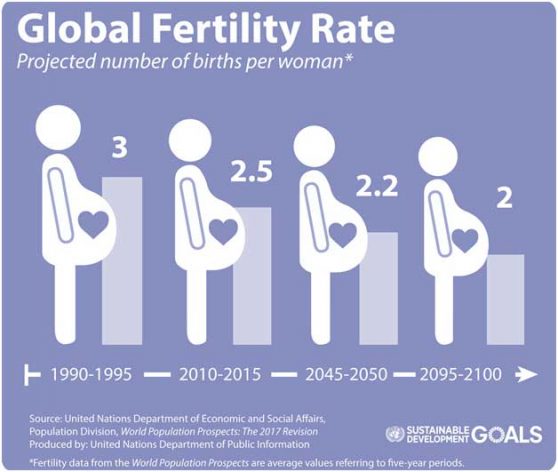By Marian Starkey
Washington, Jul 4 2019 (IPS) – Knowledge is power, but with the caveat that said knowledge is based on fact. Otherwise, it’s misinformation.
I appreciate the journalism of IPS. Similarly, I respect and spend much of my time advocating for Americans to demand that the United States support the work of the UN Population Fund (UNFPA). Therefore, I was disappointed by two elements of an IPS interview with Dr. Benoit Kalasa about efforts to address population and development challenges as they pertain to the Sustainable Development Goals (SDGs).
The Demographic Dividend
Dr. Kalasa, Director of the Technical Division at UNFPA, says that the addition of two billion people in the next 30 years will pose challenges, but will also bring “tremendous opportunity” in the form of a demographic dividend.
The demographic dividend, however, is not predicated on future population growth, but on fertility decline that follows rapid population growth. The benefits come from a changing age structure that increases the ratio of the working-age population to the youth population.
This shrinking of the base of a country’s population pyramid allows economies to develop rapidly, if the right investments are made in health, education, and employment. That’s because, during a period when a large number of adults are economically productive, a smaller proportion of young people require their support.
In addition, when fertility declines, investments in each child tend to increase, preparing a healthier, better educated generation of future workers to be more productive per capita than their parents’ generation.
The demographic dividend is typically considered a one-generation “bonus” period, but the benefits of smaller families extend far beyond that relatively short window.
Many of today’s upper middle-income countries started this century as lower middle-income or lower-income countries — mainly those in Latin America. It’s no coincidence that the total fertility rate of the Latin America and Caribbean region nearly halved, from 3.9 to 2.0, between the early 1980s and today.
Giving readers the impression that population growth can be the silver bullet that helps an economy grow — when the population is growing most rapidly in the poorest, least developed countries — is what economists in high-income countries are known for doing.
They often tout the shortsighted Ponzi scheme of population growth for continued economic gains through an increasing consumer base, with no regard for the limits of the planet to absorb that population growth.
Zero Population Growth vs. Population Control
More troubling than the faulty description of the demographic dividend was the handling of what could have been an interesting conversation about population stabilization efforts around the world by countries that signed on to the 1994 Programme of Action at the International Conference on Population and Development (ICPD) in Cairo, and by the international donor and NGO communities.
Dr. Kalasa responded to a question about the “1960s concept of Zero Population Growth (ZPG)” with a reassurance that UNFPA rejects “population control” and only supports voluntary, rights-based family planning.
Population control and ZPG are not synonymous. Zero population growth is the demographic term for a population that is growing by zero percent — neither increasing nor decreasing in size. Population control is a strategy for achieving zero population growth that is outdated and condemned by all credible groups.
It’s understandable that UNFPA would want to make absolutely clear that its mission and programs steer clear of population control. All rights-based population groups, including Population Connection (which was founded under the name “Zero Population Growth”), engage in the same reassurances.
Every Republican president in the United States since Ronald Reagan (including Donald Trump) has denied funding to UNFPA based on a fallacious interpretation of the Kemp-Kasten Amendment.
The interpretation goes like this: China has engaged in decades of coercive abortion and sterilization of its citizens. UNFPA has a program in China. Therefore, UNFPA is engaged in coercive abortion and sterilization in China.
Never mind that UNFPA’s program in China is aimed at demonstrating that rights-based family planning programs work at least as well as coercive ones. Still, because of these erroneous accusations, it makes sense that UNFPA would want to reiterate at every opportunity possible that it does not condone or tolerate population control.
Striving for zero population growth via voluntary fertility decline, however, has nothing to do with population control. Family planning programs that expand access to modern contraceptive education, services, and supplies operate for the benefit of the individuals who may choose to participate — or not — at their own discretion.
There are an estimated 214 million women in the developing world who have an unmet need for family planning: They do not want to become pregnant in the next two years, but they are not using modern contraception.
Their reasons for nonuse range from fear of side effects to living too far from a clinic to having unsupportive partners. These barriers, and more, can be address through education about myths regarding side effects; offering a full range of contraceptive options so that women can find the methods that work best for them; mobile outreach units that travel to rural areas; and partner education (and when that fails, through methods that are discreet and less likely to be detected by an unsupportive partner).
None of these strategies falls under population control, and yet they all bring us closer to zero population growth.
(Marian Starkey is Senior Director of Publications at Population Connection. She has an MSc in Population and Development from the London School of Economics.)




